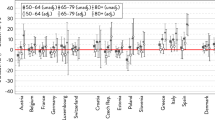Abstract
Background
Gender differences in exposure to social resources play a significant role in influencing gender inequalities in health. A related question — and our focus — asks whether these inequalities are also influenced by gendered vulnerabilities to social forces. Specifically, this paper examines the differential impact of social forces on the health of elderly (65+) men and women.
Methods
Multiple linear regression analysis is used to estimate gender differences in the influence of socioeconomic, lifestyle, and psychosocial factors on both self-rated health and overall functional health using data from the 1994–1995 National Population Health Survey.
Results
Key findings include: 1) the relationship between income and health is significant for older women only, whereas the converse holds for education; 2) having an acceptable body weight is positively associated with health for elderly women only; and 3) stress-related factors are stronger determinants of health for older women.
Interpretation
Our findings shed light on the processes of healthy aging for men and women, and suggest that interventions to improve the health of elderly Canadians need to be gender-specific.
Résumé
Contexte
Les différences dans l’exposition des hommes et des femmes aux ressources sociales influencent beaucoup les inégalités entre les sexes en matière de santé. Une question liée — celle qui nous intéresse — est de savoir si ces inégalités sont aussi influencées par la vulnérabilité différente des hommes et des femmes aux forces sociales. Plus précisément, nous analysons ici les répercussions différentes des forces sociales sur la santé des hommes et des femmes âgés (65 ans et plus).
Méthode
Par analyse de régression linéaire multiple et à l’aide des données de l’Enquête nationale sur la santé de la population (1994–1995), nous avons estimé les différences entre les sexes dans l’influence des facteurs socio-économiques, psychosociaux et du mode de vie sur l’état de santé auto-évalué et sur la santé fonctionnelle globale.
Résultats
Nos principales constatations sont les suivantes: 1) la relation revenu-santé n’est significative que pour les femmes âgées, mais c’est l’inverse pour la relation instruction-santé; 2) un poids acceptable est positivement associé à la santé, mais chez les femmes âgées seulement; et 3) les facteurs liés au stress sont des déterminants de la santé qui jouent davantage chez les femmes âgées.
Interprétation
Ces constatations éclairent en partie les processus de vieillissement en santé chez les hommes et les femmes et portent à croire que les mesures d’amélioration de la santé des personnes âgées au Canada doivent tenir compte du sexe.
Similar content being viewed by others
References
Nathanson C. Illness and the feminine role: A theoretical review. Soc Sci Med 1975;9:57–62.
Verbrugge L. Females and illness: Recent trends in sex differences in the United States. J Health Soc Behav 1976;17:387–403.
Nathanson C. Sex, illness, and medical care: A review of data, theory and method. Soc Sci Med 1977;11:13–25.
Arber S, Ginn J. Gender and inequalities in health in later life. Soc Sci Med 1993;36:33–46.
Macintyre S, Hunt K, Sweeting H. Gender differences in health: Are things really as simple as they seem? Soc Sci Med 1996;42:617–24.
Verbrugge L. Female illness rates and illness behavior: Testing hypotheses about sex differences in health. Women and Health 1979;4:61–79.
Verbrugge L. The twain meet: Empirical explanations of sex differences in health and mortality. J Health Soc Behav 1989;30:282–304.
Bird C, Rieker P. Gender matters: An integrated model for understanding men’s and women’s health. Soc Sci Med 1999;48:745–55.
Adler N, Boyce W, Chesney M. Socioeconomic inequality in health: No easy solution. JAMA 1993;24:314–15.
Roberge R, Berthelot J, Wolfson M. Health and socioeconomic inequalities. Can Soc Trends 1995;3:15–19.
Crompton S, Kemeny A. In sickness and in health: The well-being of married seniors. Can Soc Trends 1999;4:22–27.
Borg V, Kristensen T. Social class and self-rated health: Can the gradient be explained by differences in life style or work environment? Soc Sci Med 2000;51:1019–30.
Walters V, Lenton R, French S, Eyles J, Mayr J, Newbold B. Paid work, unpaid work and social support: A study of the health of male and female nurses. Soc Sci Med 1996;43:1627–36.
Walters V, Denton M. Stress, depression and tiredness among women: The social production and social construction of health. Can Rev Sociol Anthropol 1997;34:53–69.
Arber S, Cooper H. Gender differences in health in later life: The new paradox? Soc Sci Med 1999;48:61–76.
Denton M, Walters V. Gender differences in structural and behavioral determinants of health: An analysis of the social production of health. Soc Sci Med 1999;48:1221–35.
Ross C, Wu C. Education, age, and the cumulative advantage in health. J Health Soc Behav 1996;37:104–20.
Ross C, Bird C. Sex stratification and health lifestyle: Consequences for men’s and women’s perceived health. J Health Soc Behav 1994;35:161–78.
Verbrugge L. A health profile of older women with comparisons to older men. Res Aging 1984;6:291–322.
Mildred B. Health and Lifestyles. New York: Routledge, 1990.
Rowe J, Kahn R. Successful Aging. New York: Pantheon Books, 1998.
McDonough P, Walters V. Gender and health: Reassessing patterns and explanations. Soc Sci Med 2001;52:547–59.
Author information
Authors and Affiliations
Corresponding author
Rights and permissions
About this article
Cite this article
Prus, S.G., Gee, E. Gender Differences in the Influence of Economic, Lifestyle, and Psychosocial Factors on Later-life Health. Can J Public Health 94, 306–309 (2003). https://doi.org/10.1007/BF03403611
Received:
Accepted:
Published:
Issue Date:
DOI: https://doi.org/10.1007/BF03403611




